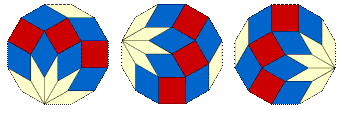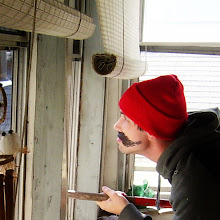This variation incorporates the idea of a game "form."
In this variation of the game, the winning condition is predetermined; the final shape is set and all moves have a predetermined outcome. In other words, all three pattern-sets can be the same, but if they do not match the predetermined design, then the winning condition hasn't been met.
This variation represents a possible manifestation of the game form, but it doesn't necessarily add greater depth to the game. However, if the predetermined design was somehow initially unknown, and learned throughout the game, it may be a worthwhile route to take.
Tuesday, November 27, 2007
first actual purchase
I bought these, Fractiles, 3 whole sets of them.
This toy resembles almost exactly what I imagined the game pieces to look like originally, which is good enough for me. I will be using these for my first prototype, the basic rules of which can be viewed in my previous blog. Eventually I hope to incorporate other aspects of the Bead Game; I feel that what I have made up so far has a lot of room for elaboration.
This toy resembles almost exactly what I imagined the game pieces to look like originally, which is good enough for me. I will be using these for my first prototype, the basic rules of which can be viewed in my previous blog. Eventually I hope to incorporate other aspects of the Bead Game; I feel that what I have made up so far has a lot of room for elaboration.
Monday, November 26, 2007
Rules for the pattern tile game version
- start with three different pattern blocks spaced about a foot apart. These will be the (abstracted) concepts you are playing with, and they will grow into larger pattern sets.

- There are three types of beads (pictured below as white, black, and gray circles), associated with the three types of pattern blocks. Every turn you will draw nine beads at random, three for each pattern set. (The beads function pretty much like cards)

first turn:
- For each pattern set, add* the appropriate blocks to the existing pattern (as pictured above). New blocks must be added so that they are touching the pre-existing pattern (shaded blocks are the “pre-existing pattern”).
*You may also subtract blocks on the outer surface of the pre-existing pattern; if you want to get rid of a square piece (that is not buried within the pattern) you may do so by spending the bead associated with square pieces, if you drew that bead for the present turn of course. - Add and subtract from your patterns until each pattern is the same.

Saturday, November 10, 2007
non-computer implementation
There are a lot of ways the Glass Bead Game could be implemented without a computer, in fact, the original presumably didn't.
As I've mentioned in other posts, Vipassana (there are a bunch of different spellings of this) Meditation is a process by which connections are made between things until the "root" of everything is discovered. This is one possible computer-free--not to mention everything-else-free--version of the game. Meditation is, in fact, sometimes taught as a game to beginners.
Other, real games exist that exemplify many of the values of a glass bead game. For example, the Rubik's Cube is a puzzle game that, in order to solve, one must be aware of everything at once; you cannot affect one side without affecting the other. The ultimate goal with a Rubik's cube is to order everything--although it leaves out the part where everything is realized as one.
Right now, I'm in the process of thinking up a board-game version of the game. This game will at least model the processes of a true game abstractly; that is, the concrete "meaning" behind game pieces will probably be left out in order to cement the game-play.
As I've mentioned in other posts, Vipassana (there are a bunch of different spellings of this) Meditation is a process by which connections are made between things until the "root" of everything is discovered. This is one possible computer-free--not to mention everything-else-free--version of the game. Meditation is, in fact, sometimes taught as a game to beginners.
Other, real games exist that exemplify many of the values of a glass bead game. For example, the Rubik's Cube is a puzzle game that, in order to solve, one must be aware of everything at once; you cannot affect one side without affecting the other. The ultimate goal with a Rubik's cube is to order everything--although it leaves out the part where everything is realized as one.
Right now, I'm in the process of thinking up a board-game version of the game. This game will at least model the processes of a true game abstractly; that is, the concrete "meaning" behind game pieces will probably be left out in order to cement the game-play.
Monday, November 5, 2007
simulation
here's an extremely rough simulation of how one board-game-type version of the glass bead game might progress. It shows the evolution of the board itself, without game pieces.
board simulation
here's a simulation of an entirely different version of the game:
stage 1
stage 2
stage 3
explanation pending
board simulation
here's a simulation of an entirely different version of the game:
stage 1
stage 2
stage 3
explanation pending
Subscribe to:
Comments (Atom)
